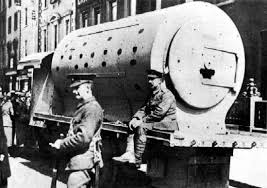
Easter is, in one sense, the most important day of the year. It is a day that we remember and celebrate the most important event in the history: the resurrection of Christ. Besides the original “Easter”, another Easter changed the world. Easter 1916 was the setting of the Easter Rising in Dublin, Ireland and this rising was very important in the history of the 20th Century. (As an aside, does anyone else think that it is ironic that this “rising” occurred on Easter of all days. I doubt the IRA planned it that way for that reason, I just find it interesting.)
On Easter Week, 1916, the Irish Republican Army (IRA) rose up against British rule. This occurred in the midst of the most devastating year in World War I. Ireland had been under the rule of Great Britain for hundreds of years but the time had come when the Irish were ready to throw off British rule and establish their own republic. Two leaders emerged in the revolutionary movement: Patrick Pearse and James Connolly. Pearse was a poet nationalist and he served as a school teacher and founded a school called St. Enda’s which sought to raise children to be Irish nationalists by teaching the Irish language in the school. Connolly was a socialist and Irish nationalist who founded the Irish Citizen’s Army. Both leaders combined their strength in the spring of 1916 to give Ireland a chance at being free.
The revolutionary force was comprised of Pearse’s Volunteer Army, Connolly’s Irish Citizen Army and the Cumann na mBan, which was a female version of the Volunteer Army. On the morning of Easter Monday, the IRA seized the Dublin General Post Office (GPO) and several other sites around the city. Their hope was to seize the railroads and ports, so as to deter British troops from entering the city. They failed to do so in the critical first few days of the uprising. Furthermore, their attacks on Dublin Castle, the seat of the British government in Ireland, and Trinity College also failed. The Irish rebels retreated from Dublin Castle because they feared that they would be overwhelmed by hundreds of defenders. In reality, only two dozen or so British troops guarded the castle. Had Dublin Castle fallen, things may have gone differently. But Dublin Castle did not fall and Trinity College was defended by armed students. Railroads and ports were not secured by the IRA and soon, British reinforcements entered the city and took to fighting the IRA in the streets. Despite these setbacks, the IRA established a Provisional Government in the GPO.
With more and more British troops entering Dublin, the days of the Provisional Government were numbered. After the GPO was shelled intensely and reports of British soldiers murdering civilians in the streets started coming in, Pearse was forced to surrender the GPO to the British forces under William H. M. Lowe. Pearse, Connolly and the other rebel leaders were executed and the rebellion became a thing of the past. Or so many people thought. The Irish independence party, Sinn Fein, won a great electoral victory in 1918 and they adopted a Declaration of Independence in 1919. Ireland was free, despite the defeat that the IRA suffered in Dublin in 1916.
In reality, the Dublin Easter Rising had effects reaching far beyond Ireland. One of the bystanders in the Dublin conflict was a photo-journalist named Ho Chi Minh. What he saw in Dublin in 1916 would shape his actions in Vietnam in the 1950s and 1960s. Indeed, the Dublin Easter Rising paved the way for the Decolonization of the British and French Empires decades later.
Interesting Fact of the Week-During the First Balkan War in 1912, the Ottoman Empire fought the Balkan League. The first Balkan country to declare war on the Ottomans was the tiny nation of Montenegro.
Inspiring Quote of the Week-“A small body of determined spirits fired by their unquenchable faith in their mission can alter the course of history.” -Mahatma Gandhi
